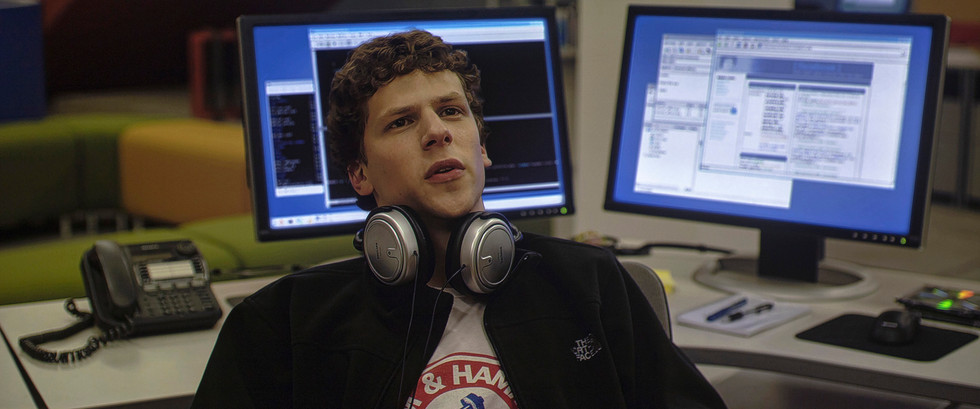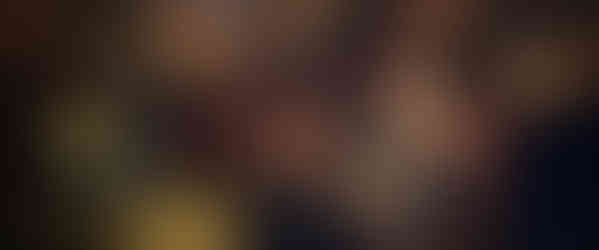Fincher’s “The Social Network” makes the cut – Columbia Classics 4K Ultra HD Collection Vol. 2
- Bill Kelley III

- Oct 13, 2021
- 7 min read
Updated: Jun 5, 2022
4K ULTRA HD REVIEW / HDR FRAME SHOTS
(1) Mark Zuckerberg (Jesse Eisenberg) celebrates the selection of the first three Facebook summer interns, after a shot glass coding contest. (2) Zuckerberg at the new Facebook headquarters in San Francisco.
(Click on an image to scroll through the larger versions)
“THE SOCIAL NETWORK” – COLUMBIA CLASSICS COLLECTION VOL. 2
4K Ultra HD, Blu-ray, Digital copy; PG-13 for sexual content, drug and alcohol use and language 2010; Streaming via Amazon Prime Video (4K), Apple TV (4K), Movies Anywhere (4K), Vudu (4K), YouTube (4K)
Best extra: The four-part “How Did They Ever Make a Movie of Facebook?” (disc & digital)
JUST OVER a week ago, Mark Zuckerberg, creator of Facebook lost $6 billion in one day, when his social media app and Instagram suffered an outage that lasted six hours. Influencers and small businesses that relied on the platforms to connect with followers and fans who advertise and sell products lost from hundreds to thousands of dollars from sales, sponsored posts, and product launches, says CNBC.com “It’s a demonstration of just how big Facebook’s influence is over the online economy.”

So, after the Facebook snafu, it made perfect sense to first review David Fincher’s “The Social Network” (2010), one of the six movies featured in the new “Columbia Classics 4K Ultra HD Collection – Volume 2.” The box set also includes Otto Preminger’s courtroom drama “Anatomy of a Murder” (1959) starring James Stewart as defense attorney Paul Biegler; Carol Reed’s Best Picture adaptation of Charles Dickens’ “Oliver! (1968); Martin Scorsese’s psychological thriller “Taxi Driver” (1976) with Robert De Niro as the deranged New York City cabby Travis Bickle; the oddball of the set Ivan Reitman’s comedy “Stripes” (1981) starring Bill Murray as the screwball U.S. Army recruit John Winger and Ang Lee’s beautiful adaptation of Jane Austen’s “Sense and Sensibility” (1995) following life at the Dashwood estate and its three daughters Elinor, the oldest, (Emma Thompson), Marianne (Kate Winslet) and the youngest Margaret (Emile Francois).
(1) Zuckerberg is dumped by his Boston University girlfriend Erica Albright (Rooney Mara). The scene required 99 takes, with a variety of camera angles to satisfy the director. (2&3) Zuckerberg races back to his Harvard dorm room (exteriors filmed at John Hopkins University) to write an insulting entry about Albright on his LiveJournal blog. Then he creates a campus website called Facemash, which allowed site visitors to rate female students. The site caused the Harvard servers to crash at 4 a.m.
In “The Social Network” Harvard student Zuckerberg (Jesse Eisenberg) faced similar outages during the early days of his Facebook creation. “The difference between Facebook and everyone else: we don’t crash! If the servers are down for a day, our reputation is destroyed,” yells the computer genius while on the phone with his friend and co-founder Eduardo Saverin (Andrew Garfield). Zuckerberg had moved Facebook to Palo Alto, California, to be close to the Stanford University campus, while Saverin was stuck in New York City lining up advertisers and sponsors. To get Zuckerberg’s attention he closed out all of the credit cards and checking account, right when they needed to buy more servers to keep the social media platform up and running. Screenwriter Aaron Sorkin says in the enclosed 80-page hardcover coffee table book highlighting each film, Zuckerberg was driven by obsession, trying to find a “way to break out of the pack and not feel like such a loser.”
Fincher, a noted perfectionist and considered one of Hollywood’s best (“Se7en,” “Zodiac,” “The Curious Case of Benjamin Button”) spent 70 days filming “The Social Network,” considered about 35 more days more than a traditional film. The opening sequence filmed at The Thirsty Scholar in Somerville, Massachusetts, where Zuckerberg was dumped by his girlfriend Erica Albright (Rooney Mara) took 99 takes with a variety of camera angles, to satisfy the demanding director, writes Nev Pierce writes in his enclosed essay.
With a grand total of 268 hours of footage, Fincher’s final edit was highly decorated receiving eight Oscar nominations, winning three golden statues including Best Film Editing, Best Adaptation for Sorkin’s Screenplay, and another for the icy electronic score by Trent Reznor and Atticus Ross. The late film critic Roger Ebert selected it as his No. 1 film of the year, ahead of the Academy Awards’ Best Picture winner “The King’s Speech.”
The storyline bounces between the dysfunctional Zuckerberg and the Facebook explosion to other colleges and universities, as he became the world’s youngest billionaire. A good part follows the competition and betrayal, as Napster co-founder Sean Parker – wonderfully played by Justin Timberlake – provides the sleazy and hustle, while two lawsuits hung over Zuckerberg.
The Legal Battle
(1&2) Zuckerberg, sued by the Winklevoss twins (Armie Hammer & Josh Pence), who claimed he stole their idea from Harvard Connect, from which Zuckerberg created Facebook. Cameron and Tyler Winklevoss received a settlement of $65 million, signed a non-disclosure agreement, and went on to participate in the 2008 Beijing Olympics, placing sixth. (3-5) Former friend and co-founder of Facebook Eduardo Saverin (Andrew Garfield) sued Zuckerberg for unfairly diluting his percentage when it was incorporated. Saverin received a settlement of an unknown amount and his name was restored to the Facebook masthead as a co-founder.
EXTRAS
The 4K only includes a trailer, while the decade-old Blu-ray carries over the original extras featuring two commentaries – one with Fincher and second with Sorkin and the cast with Josh Pence (Tyler Winklevoss), Armie Hammer (Cameron Winklevoss), Garfield, and Eisenberg who relived the opening scene (99 takes from a variety of angles), which was filmed on day three. It gave him the opportunity to figure his character (Zuckerberg) and the “confidence to pursue the rest of the movie. After we were finished, I felt a big weight off my shoulders.” The young actor admitted he suffers panic attacks – especially before big scenes. Fincher recalled seeing Eisenberg’s audition video clip, which was from the 10-page opening scene, “I thought wow! That’s pretty undeniable. And, I dragged Sorkin into my office and he said, ‘the largest job is done.’”
A second Blu-ray and digital features the excellent 92-minute behind the scenes documentary “How Did They Ever Make a Movie of Facebook?” with footage of the three weeks of rehearsals, during which Fincher examined every word in the script, to the last day of shooting and interviews with the cast and crew including screenwriter Sorkin who said, “The thing that grabbed me was the elements of this story that are as old as storytelling itself, of friendship and loyalty, jealousy, class, power, betrayal.” Next the costume fittings and camera tests in L.A., before heading to Boston, and getting sandbagged by Harvard over filming on the campus in the fall of 2008. John Hopkins University in Baltimore ended up subbing for Harvard. You'll get a close-up look at the 10-page opening scene, where dozens of extras speak at normal volume – an oddity – as Eisenberg and Mara act out their lines.
“There’s going to be no improvisation on this kind of script. It’s too dense and language-oriented. There’s gotta be a precision of language while causalizing the language.” – Oscar-winning screenwriter Aaron Sorkin
The third part heads back to L.A., where the Santa Monica Bay Women’s Club subbed for a Harvard auditorium; a boiler room computer coding contest to select the three Facebook interns; the Palo Alto rental house and swimming pool, and meeting Sean Parker at a restaurant. The fourth part highlights the scenes filmed on soundstages mostly interiors including the bedrooms, and the office tower lawsuit meetings.
Additional featurettes with film editors Angus Wall and Kirk Baxter plus sound designer Ren Klyce detailing the editing layers and sound effects; Reznor and Ross discussing the process of creating the score and the Swarmatron sound machine, and final with cinematographer Jeff Cronenweth and Fincher explaining look of the film.
The Move to California
(1-4) Sean Parker (Justin Timberlake), co-founder of Napster, spends the night with Stanford University student Amelia (Amy) Ritter (Dakota Johnson), and discovers she has a Facebook profile. Parker wants a part of the Facebook action and convinces Zuckerberg to move Facebook to California’s Bay Area, just down the street from the Stanford campus.(5) Zuckerberg rents a house in Palo Alto with a swimming pool. The three summer interns work around the clock as Facebook explodes globally on college campuses.
VIDEO
Fincher and Cronenweth (“The Girl with the Dragon Tatto” (2011), “Fight Club”) decided to capture the drama on the first RED One 4K digital cameras (2.39:1 aspect ratio) outfitted with the 12-megapixel MYSTERIUM senor, with excellent low light ability and a greater range in the color spectrum. Still, overall clarity can’t match the more refined cameras of today. Dozens of tight shots are missing that extraordinary fine detail found on the newer 4K or 6.5K cameras, plus it was originally mastered in 2K. The on-screen resolution is nearly a dead-heat between the 4K and the older Blu-ray, though, ultimately a slight edge goes to the 4K with the finest detail on costumes and faces. When it comes to contrast and color, the 4K has a clear advantage. Fincher provides dozens of notes for readjusting the contrast and colors to recreate his original intent for “The Social Network.”
The HDR re-master grading with HDR10 and Dolby Vision has reset the highlights and mid-tones with more definition, removing the blown-out highlights that plagued the Blu-ray. Color is more desaturated in the interiors, and the facial toning is natural removing the excess reddish tint found on the previous HD versions. “The director was able to take up where he left off ten years ago with his exacting aesthetic, refining even more with equal amounts of excitement at the opportunity to revisit one of his stand-out works,” writes Rita Belda in the book. They also readjusted brightness and contrast where distracting lighting or sharp areas took the audience away from the storytelling. In some frames, the contrast was softened to remove the hot spots or over-bright backlighting.
AUDIO
The new eight-channel Dolby Atmos soundstage (Unrated track) comes alive, expanding the soundstage from front to back and floor to ceiling. Height speakers are extremely active pushing environmental effects: voices, music, and laughter during the bar scenes. The disco scene has never sounded more authentic. My subwoofer has never pushed such low bass frequencies. My projector had the hardest time keeping from showing vibrations. The bass was so intense it caused my wife to get out of bed, even though my theater room is very isolated from the rest of the house. That’s never happened before.
“The Atmos mix nicely expands upon the original soundtrack, giving its unique elements more life and impact,” says Brian Vessa, who worked with the original sound designer Ren Klyce.
Overall, this is not a night and day difference from the previous editions, However, the new HDR and Atmos remastering gives Fincher’s film a more cinematic experience.
— Bill Kelley III, High-Def Watch producer








































Comments